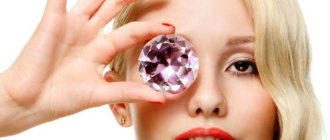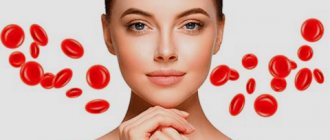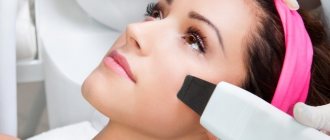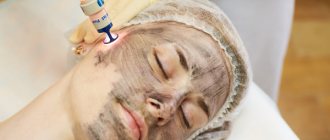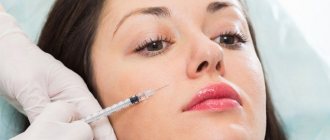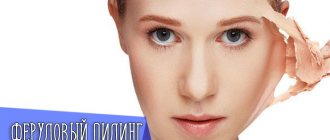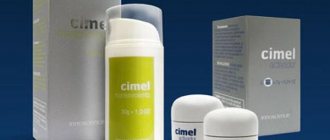- Indications
- Contraindications
- Peculiarities
- Kinds
- Stages
- Actions
- Side effects
- Rehabilitation
- Independent use
- pros
- conclusions
The cosmetology market offers various types of peelings for skin renewal. One of the most promising pharmaceutical agents is azelaic acid, which is included in many medications and, through chemical exfoliation, eliminates skin imperfections and initiates natural rejuvenation processes. The procedure has variations that are taken into account depending on the initial state of the epidermis and the expected results.
What is azelaine peeling?!
Azelaine peeling is a subtype of superficial chemical peeling for gently cleansing the skin and resolving some dermatological problems. The main component of the composition is natural azelaic (nonandioic, 1.7-heptane dicarboxylic) acid, which belongs to the group of dibasic saturated carbon compounds and is obtained by oxidative ozonation of oleic or linoleic acids, and is also found in wheat and barley. The substance normalizes metabolic processes and restores the cellular structure of the skin.
Indications for the procedure
Azelaine peeling has no age restrictions and can be performed on any skin type. The main thing is to determine what problem the procedure should cope with.
Indications for the use of azelianic acid are as follows:
- Acne, folliculitis, rosacea, rosacea, other dermatological diseases.
- Excessive pigmentation.
- Ingrown microhairs.
- Acne and its consequences.
- The appearance of facial and age wrinkles, signs of photoaging.
- Seborrhea, melasma.
- Preparation for laser peeling or microdermabrasion.
Indications for azelaine peeling
- Inflammatory and non-inflammatory forms of acne as part of complex therapy.
- Oily and seborrheic skin, enlarged pores.
- Demodicosis is an acne disease caused by skin mites.
- Folliculitis is an infection of the hair follicles.
- Hyperpigmentation of various origins: melasma, chloasma, lentigo, freckles.
- Prevention and correction of chrono- and photoaging: wrinkles, sagging, decreased tone, dryness, gray complexion.
- Sensitive skin with a tendency to peeling and redness.
- Cuperosis is a vascular “mesh”.
- Hyperkeratosis is a thickening of the upper layer of the epidermis.
- Skin defects: ingrown hairs, small scars, scars on the face and body.
- Preparation for serious cosmetic procedures: laser resurfacing, microdermabrasion, deep peelings and cleansing.
Contraindications for azelaine peeling
- Pregnancy, lactation.
- Increased body temperature.
- Acute inflammatory and infectious processes: herpes, pyoderma, microsporia.
- Malignant and multiple benign neoplasms.
- Severe damage to the cardiovascular, urinary and digestive systems.
- Damage to the skin: wounds, burns.
- Exacerbation of chronic dermatoses: psoriasis, eczema.
- Increased skin insolation.
- Constant use of hormonal medications, systemic and topical retinoids.
- Autoimmune diseases: systemic lupus erythematosus, scleroderma.
- Individual intolerance to ingredients.
Contraindications
List of contraindications for azelaine peeling:
- Pregnancy and lactation period.
- Exacerbation of herpes.
- The presence of open wounds, scratches, ulcers.
- Individual intolerance.
Even if you want to carry out the procedure yourself, you should seek advice from a certified specialist, especially if you have not previously used azelaine peeling. Reviews from cosmetologists say that there is nothing complicated about it, but you need to have some experience. Their advice will help you complete the procedure without harm to your health and achieve the maximum positive effect.
Features of azelaic acid
- It is combined in peelings with mandelic, lactic, salicylic, and glycolic acids to enhance the effect and solve the assigned problems.
- Regulates the level of acidity in cosmetic products, therefore it is successfully used in cosmetology.
- It does not cause resistance to pathogenic microorganisms even with constant use, so courses of procedures are highly effective.
- It has a gentle exfoliating effect, not a scraping effect, unlike other fruit acids, so it is suitable even for sensitive skin.
- It has great “penetrating” ability, passes between the cells of the stratum corneum and quickly cleanses the skin.
- Reduces the activity of 5-alpha reductase and polyunsaturated fatty acids, therefore reducing excess sebaceous secretion.
- Azelaic acid derivatives in cosmetology are water-soluble, chemically stable compounds with improved whitening properties.
- It is perceived by the skin as a related chemical compound, since it is formed in small quantities as a result of fat metabolism and is found in epidermal cells.
Side effects and complications
If the manipulation is carried out correctly, no negative reactions should occur. Only errors in carrying out and preparing for azelaine peeling can lead to the following side effects and complications:
- dry skin;
- enlarged pores;
- swelling of tissues;
- infection in the tissues of the face and neck;
- allergy to a cosmetic product (rash, burning or irritation);
- increased pigmentation;
- skin hypersensitivity;
- the appearance of keloid scars.
We recommend: Is it possible to do intimate peeling? Features of the procedure and technique
Stages of azelaine peeling
- Consultation and examination - collecting anamnesis, identifying contraindications, designating a treatment regimen.
- Preparation - use of moisturizing creams with 5-10% AHA acids to adapt and smooth the skin 10-14 days before the start of the course.
- Sensitivity test - applying an exfoliant to the crook of the elbow for 30 minutes to detect allergic manifestations.
- Cleansing before peeling - removing impurities using milk or foam with natural moisturizing ingredients.
- Degreasing - rubbing with lotion with 3% glycolic acid to enhance penetration of ingredients.
- Protect mucous membranes, lips, and corners of the eyes with special preparations containing petroleum jelly or silicone polymers to prevent acid from entering vulnerable areas.
- Peeling - treatment of the skin with 15-30% azelaic acid with pH 1.8-3.0 in 1-3 layers by massaging for 5-10 minutes from the periphery to the center: forehead, temples, cheeks, chin, eyelids, nose, nasolabial triangle. The exposure time and number of layers may vary depending on the type of preparation.
- Removing the composition with cool water.
- Applying soothing agents - licorice extract, retinol, vitamin E and sunscreen.
What does the drug contain?
Peeling contains several active ingredients:
| Active substance | Azelaic acid (concentration 15–30%) |
| Auxiliary Connections | Mandelic, salicylic, lactic, glycolic, phytic, citric acids |
There are several types of azelaine facial peeling, differing in additional components. Extracts of medicinal plants (calendula, thistle, horse chestnut), essential oils (olive, chamomile), hyaluron, vitamin substances, plankton extracts, and seaweed can be added to skin cleansing products.
Actions of azelaine peeling
- Anti-inflammatory - reduces painful rashes and prevents redness from recurring in the skin and hair follicles.
- Sebum regulating – normalizing the functioning of the sebaceous glands, reducing acne and enlarged pores.
- Keratolytic - stimulation of exfoliation of the stratum corneum, inhibition of keratinocyte growth and cleansing of pores.
- Antiseptic - stopping the spread of harmful microorganisms - fungi and bacteria, preventing infection of the skin.
- Whitening - regulation of the distribution and production of melanin.
- Antioxidant - neutralizes toxins and free radicals.
- Renewing - normalization of microcirculation processes and strengthening of blood vessels.
- Regenerating and rejuvenating - restoring cell division, stimulating barrier structures, increasing tone, reducing wrinkles and evening out tone.
Course of procedures
The basic duration of sessions is 5-12 procedures with an interval of 1 time every 7-14 days. The technique can be repeated after 2-4 months, depending on the condition of the skin and the goals being achieved. Maintenance course - once every 6-8 months.
Side effects
Immediate (2-4 weeks after procedure):
- Dry skin after azelaine peeling is a natural reaction to the action of the peeling. It is removed with soothing gels, masks with aloe, collagen, and chamomile extracts.
- Swelling is an expected manifestation of the composition. Corrected with moisturizing preparations with antioxidant substances.
- Exacerbation of herpes infection - occurs due to individual characteristics or incorrectly collected anamnesis. Controlled by prescribing antiviral drugs.
- Attachment of a secondary infection - manifests itself due to non-compliance with recommendations or violation of antiseptic rules during the procedure. Antibacterial drugs are prescribed.
- An allergic reaction is a response mechanism to the penetration of azelaic acid in the absence of a preliminary sensitivity test. Antihistamines and local regenerating substances are taken.
- Erythema is post-peeling redness of the skin, which is observed within 2-3 hours. In case of persistent manifestations, procedures are carried out to normalize microcirculation in skin cells.
- Hyperpigmentation is a rare undesirable manifestation that occurs when the steps of the procedure are not followed.
- Exacerbation of acne is a possible consequence, which disappears on its own 2-3 months after peeling. Additionally, anti-inflammatory gels (Skinoren, Kuriosin) are prescribed.
Persistent (4-10 weeks after using azelaine peeling) - keloid scars, depigmentation - occur due to internal disruptions in the body, incorrect medical history, and ignoring the recovery period. Restorative drugs and procedures are used.
Rehabilitation period
- Do not apply decorative cosmetics for 24-48 hours.
- Do not visit the bathhouse, swimming pool, sauna, or solarium for 14 days.
- For 5-14 days, use light texture care products to moisturize.
- For 7-15 days, cleanse the skin with milk, foam with aloe extract, collagen, chamomile.
- Apply regenerating and restorative components for 3-5 days.
- For 5-10 days, do not carry out aggressive procedures: scrubs, polishing.
- Always use sunscreens with an SPF of 30 or more. For example, cream block for tanning and age spots, SPF 45.
Prices and brands of peelings
The average cost of one azelaine peeling session varies from 1,800 to 4,000 rubles, depending on the region, the drugs used and the qualifications of the cosmetologist.
The total cost of professional cosmetics for pre-peeling and post-peeling care ranges from 7,000 to 15,000 rubles. The exact price of the course is communicated to the patient by the attending specialist after assessing the condition of his skin. In Russian beauty salons, compositions for azelaine peeling are most often offered from the following manufacturers: KleoDerma (Germany), Sesderma (Spain), Oxygen Botanicals (Canada), Mariskin (France) and many others.
The products used by cosmetologists during procedures include chemical peeling compounds, bioconcentrates for strengthening capillary walls, cleansing lotions for the face and décolleté, moisturizing antibacterial gels, nourishing face creams with gel, fluid and dense textures, and much more.
Tags: other
Market Analytics
- Black Lives Matter movement: reaction and consequences for the beauty industry
- COVID-19 is changing the rules of the game in the cosmetics market
- Beauty of the future: cosmetic innovations 2020
Convenient search for beauty salons on our website
Beauty salons in Moscow Beauty salons in St. Petersburg Beauty salons in Ekaterinburg Beauty salons in Novosibirsk
Latest blog posts on our website
- Naturecream / Apricot kernel oil for face
- Naturecream / MATRIXYL3000 - the best skin elasticity stimulator
- Naturecream / SPF in Natural Oils
- Naturecream / Geranium (Pelargonium) oil for skin health and beauty
- Prostye-sovety / Save on a beauty salon: procedures that can be done at home
- Naturecream / Growth Factor - brings back youth?
- Oksana-Lezina / 3 effective abdominal exercises from a fitness instructor for beginners
- Prostye-sovety / Making perfect curls at home
- Prostye-sovety / Which hair removal method to choose
- Naturecream / Wrinkles Puppets
Latest forum topics on our website
- Natalya / How to properly make a gelatin mask?
- Mrs._Smith / Badly sunburned! What to do?((
- Ice / Is it necessary to combine fitness classes with a diet?
- Antonova / What can be used for hair loss?
- Radio operatorKat / Who was on a protein diet?
Reviews about the
Azelaine facial peeling [Leave a review]
Leave your feedback about this procedure (it will appear on this page after moderation)
In this form, describe only
your personal
experience of undergoing the procedure.
In order to leave a comment regarding the content of the article, use another form - in the “comments” block at the bottom of the page.
Other articles in this section
| Phenol peeling for the face Phenol peels refer to skin exfoliation procedures performed using carbolic acid (phenol). Deep peeling affects all layers of the epidermis, right down to the papillary layer. The extreme length of the rehabilitation period, reaching 12 months in some cases, and the high risk of severe complications require a particularly careful approach. |
| Laser facial peeling Laser peeling, performed on the facial skin, is one of the physical rejuvenation techniques. It is based on the use of monochrome light radiation, which is a single wavelength, which, when exposed to tissue, leads to selective photothermolysis. As a result of this reaction, over 95% of the laser radiation energy is absorbed by one target tissue and is further converted into heat. As a result, the patient experiences selective evaporation of layers of skin, which makes it possible to remove age spots, acne scars, expression lines and some other skin defects. |
| Antioxidant Red Peel for the face Red Peel is an antioxidant two-phase chemical peel developed by the Italian company GOES. It belongs to the new generation of chemical peels. The originality of the peeling lies in the combination of pyruvic acid, ROC antioxidant complex, nanomolecular encapsulated retinol and hyaluronic acid. |
| Apple peeling for the face The apple contains many useful trace elements, minerals and various polyphenols, pectins, vitamins and other substances, so it is considered one of the healthiest fruits for humans. One of the substances included in its composition is apple cider vinegar, the properties of which make it possible to successfully use cosmetic preparations made from apples to cleanse the skin. |
| Salicylic peeling for the face Salicylic peeling has a powerful anti-inflammatory, antiseptic and keratolytic effect, it helps to normalize the functioning of the sebaceous glands and narrow pores. This peeling is indicated for young oily skin with minor problems, as well as for mature skin with signs of photo- and bioaging. |
| ABR peeling for the face ABR peeling is a combined medium peeling that is used mainly for oily problem skin. This is one of the best remedies for correcting post-acne and stagnant spots. ABR peeling refers to the process of skin exfoliation under the influence of drugs with the following active ingredients: A – AHA (alpha hydroxyl acids); B - BHA (beta-hydroxy acids); R – vitamin A (retinol). |
| Ultrasonic peeling or ultrasonic facial cleansing Ultrasonic peeling is a procedure that provides hardware facial cleansing, exfoliation, and renewal of the surface layers of the skin under the influence of high-frequency vibrations. This procedure is also called ultrasonic facial cleansing. Experts recognize ultrasonic peeling as one of the mildest types of cleansing, which allows you to remove only the superficial layers of the epidermis, eliminate acne and dirty comedones, smooth out wrinkles, improve hemodynamics, provide natural hydration and lifting. |
| Antioxidant peeling Sun Peel (Sun peeling) for the face Many representatives of the fair sex have overly sensitive skin, so in the summer, pigment spots appear on the face. In order to refresh the skin, give it radiance and get rid of hyperpigmentation, doctors recommend using safe antioxidant peeling Sun Peel. |
| Alpha-peptide facial peeling Alpha-peptide peeling refers to chemical peels of superficial or medium action, depending on the concentration of alpha hydroxy acids and pH level. Alpha peptide peeling is specially designed for aging skin with age-related changes. This type of peeling promotes the renewal of dermal and epidermal cells, reduces the visibility of deep wrinkles, disappears superficial ones, and also has a good lifting effect and moisturizing. |
| Almond peeling for the face Almond peeling is a superficial chemical peeling, which is considered one of the most gentle. The use of peeling with mandelic acid is also possible in the summer, since it does not have photosensitizing effects. It is suitable for people with different skin types, including very sensitive, thin skin. |
Self-use of azelaine peeling
- At home, azelaic acid is used in low concentrations - up to 15%.
- A preliminary consultation with a doctor is carried out to determine the type of procedure and identify possible allergic manifestations.
- The skin is cleansed and degreased with a glycolic acid-based tonic under sterile conditions.
- The delicate areas around the treated areas are protected with Vaseline.
- Azelaine peeling is rubbed into the skin with massage movements for 10 minutes, then washed off with chilled water.
- After the procedure, moisturizers are used and generally accepted post-care recommendations are followed.
How does the procedure take place?
Before performing facial peeling at home, you need to consult a cosmetologist so that he can assess the condition of the epidermis. After completing all the preparatory manipulations, you need to proceed directly to the procedure. First, the master thoroughly cleanses the skin of makeup and dirt. For this purpose, a special milk based on natural ingredients is used. Then you need to degrease your face. Glycolic acid should be applied, which will evenly saturate the skin. Thanks to this, it is possible to obtain deep penetration of the components into the layers of the epidermis.
Next, you need to protect your eyes, mucous membranes and lips. Then you need to apply special chemical compounds to your face that will block the drug from reaching sensitive areas. After this, the cosmetologist proceeds to perform peeling. A special product must be rubbed into the epidermis for 6-8 minutes. After the specified time, you need to wash off the composition using cold water (necessarily distilled). Next, dry the skin with paper towels. At the final stage, it is necessary to apply an emollient cream that will soothe the epidermis. After this, it is forbidden to wash your face for 4 hours.
The duration of the procedure is 35-40 minutes. During manipulation, the patient may experience slight itching, burning and heat. The results of the peel last for 6 months, and then it must be repeated.
After cleansing with azelaic acid, the recovery period lasts for a week. Immediately after completion of the procedure, the skin turns red, dryness and swelling of the epidermis is felt. Sometimes there may be peeling of the face that lasts for 48 hours. For 1-2 days, cosmetologists advise not to touch the skin with your hands and visit crowded places less. This is necessary to avoid infection and reduce the risk of age spots. During the entire rehabilitation period, you should cleanse your face with a special milk, as well as apply post-peeling and moisturizing creams. It is very important during this period to protect the skin from the aggressive effects of sunlight. You can learn about peeling with bodyaga at home in this article.
Going to saunas, swimming pools and gyms is allowed 14 days after completing the peeling course. During this period, it is better not to drink alcohol or smoke. This is explained by the fact that nicotine and alcohol slow down the processes of epidermal cell division.
The video shows how the procedure occurs:
Sometimes exacerbations may occur during the rehabilitation period. Very often, women with problem skin exhibit hypersensitivity. To solve this phenomenon, creams based on natural oils are used. Sometimes erythema is observed, but this only happens if the woman immediately after the procedure goes to a bathhouse, solarium or swimming pool. You can find out if you can do peeling after cleansing your face by following the link.
If hyperpigmentation occurs, products that have a whitening effect should be applied to the skin.
If excessive drying of the skin occurs as a result of azelaine peeling, to get rid of this problem, you need to apply a soothing gel or make a mask with the addition of aloe, rich cream and chamomile decoction. If an infection occurs on the skin after peeling, you will have to take antibiotics, which should be prescribed by a dermatologist. You can remove enlarged pores using any tonic that does not contain alcohol.
Benefits of cleansing your face with azelaic acid
Peeling based on azelaic acid improves the secretion of the sebaceous glands and normalizes their self-cleaning. This prevents the formation of blackheads on the face. This skin cleansing has a mild whitening effect. This helps reduce pigmentation levels. This procedure is also popular because it prevents the growth of bacteria. The advantage of peeling is that it is suitable for any skin type. This cleansing helps tighten pores and even out complexion. You can find out how to make Botox at home here.
The video shows the result of the acid:
Carrying out such a procedure effectively treats skin diseases and also prevents their further development. This is especially true for women with oily skin, because they can bring their face into perfect order. After such cleansing manipulations, you can even get rid of acne scars. You can find out how to make peeling for oily skin at home here.
Advantages of azelaine peeling
- Versatility - carried out for any phototype.
- All-season - does not increase skin sensitivity to sunlight.
- Highly effective with repeated use - no pathogenic microorganisms resistant to peeling.
- Atraumatic and delicate impact.
- Availability and ease of use.
- Activity and safety.
- Short recovery period.
- Well tolerated - azelaic acid is a natural substance for the body.
Minuses
- Course methodology.
- There is a risk of side effects.
- Low effectiveness for severe and progressive skin defects.
Healing period
After the procedure, the face will become pink. The recovery process itself will take up to two weeks. During this period it is necessary to help the skin, and for this you need:
- moisturize the skin as much as possible, but use products with a light texture;
- refuse to use products with coarse abrasive particles;
- protect the skin from sun exposure (to do this, apply products with an SPF effect of at least 50 to the face and neck);
- if necessary, use restorative ointments;
- take antiviral medications;
- refuse to visit baths, saunas and swimming pools, postpone strong physical activity;
- hide your face from the sun's rays.
Cosmetologists advise purchasing post-peeling products of the same brand as the peeling itself. This way the procedure will bring maximum benefit.
Advantages compared to analogues
The popularity of procedures with azelaic acid is due to minimal trauma to the skin. This is one of the most gentle types of peeling; there is no peeling, redness, itching, burning or other side effects.
This procedure takes place without complications. Since the mild irritating effect is only on the superficial layers of the skin, a long and complex rehabilitation period is not necessary. So within a few hours after peeling, a person can continue to do their usual activities and lead a normal daily routine, unlike other types of acid cleansing.
In addition, it can be performed quite often, if indicated, since resistance to azelaic acid does not appear.
Also, after peeling, the dermis does not become rough, which means that after some time comedones do not form due to “clogged” sebaceous glands.
Another benefit of azelaic acid is the elimination of age spots on dark skin.
For information on the mechanism of action of azelaic acid, watch this video:
How peeling works
What effect does azelaine peeling have on the skin?
- Anti-inflammatory. The acid quickly penetrates into the living layers of the epidermis, where it releases fatty acids, which have an anti-inflammatory effect.
- Vascular strengthening - has a beneficial effect on all nearby, even small vessels, this improves erythema on the face;
- Sebum-regulating – the natural secretion of sebum is reduced. This is good for skin that has high oil content. It is immediately noticeable by its oily sheen;
- Antibacterial - yes, acid is an active fighter against bacteria;
- Whitening - the acid first inhibits tyrosinase, and this then evens out the natural tone.
Peeling is easy to use constantly, the skin does not have an addictive effect. Especially when several procedures are really necessary. After all, acute skin problems cannot be removed with one procedure. More often, this peeling is prescribed specifically against acne, and of varying severity. Doctors actually clarify that acid helps well if acne is caused by bacteria. Only a doctor can find out the exact cause.
Important: before deciding to use any of the deep cleansing methods at home, you should seek the support of a doctor. Especially those who have various skin problems
Only a specialist can identify the causes of problems and suggest the most effective method for solving them.
Patient reviews
In reviews, patients note that cosmetics from the Cytolife company help improve the condition and appearance of the skin. Pigment spots lighten and decrease, wrinkles are smoothed out, the tone and elasticity of the epidermis is restored.
Cytolife peelings are an effective solution for those with oily skin types. They help fight acne and rashes, reduce acne marks, and make your face clean and fresh.
Women who have used Cytolife peelings claim that these cosmetics are excellent for home self-care. They are convenient and easy to use, they can be applied to the skin at any time of the year.
But patients agree that the procedure should be approached with the utmost caution. It is best if the first skin cleansing session is performed by a professional cosmetologist. This will help you study all stages of the procedure and avoid unpleasant consequences.
Advantages and disadvantages
This type of treatment of sensitive facial tissues is rightfully considered one of the most gentle. When exposed to the dermis, azelaic acid does not provoke peeling and inflammation.
Peeling effect:
- delicate action;
- does not require a long recovery period;
- can act as a preparatory stage for other cosmetic procedures;
- pathogenic microorganisms do not acquire resistance in case of repeated use;
- bacteriostatic effect;
- does not provoke keratinization of the upper layers of the skin, negating negative side effects;
- helps in the fight against hyperpigmentation (especially important for those with dark skin tones).
The gentle effect is not only an advantage, but also a disadvantage of the procedure; additional measures may be required to eliminate some skin diseases. Over time, another course may be required.
The popularity of peeling using azelaic acid is explained simply - gentle cleansing of the dermis does not reduce the effectiveness of the procedure.
How milk peeling works and what reviews are left by those who have undergone the procedure can be read in a separate article. Why facial myostimulation is needed and what contraindications this technique has, you will find out by clicking here.
What is the principle of operation, the benefits and harms of electrophoresis, you can find out here.
Instructions for use (5 steps)
Peeling is carried out in the following sequence:
- Before peeling, you must thoroughly cleanse your face of dirt, makeup, and degrease the epidermis.
- Apply 1 thin layer of product to skin. Distribute using rubbing movements until your fingers stop slipping.
- Azelaic acid should not be allowed to come into contact with the mucous membranes of the mouth, nose, or eyes. Wait until completely dry and apply the 2nd layer.
- If necessary, the composition can be distributed pointwise, only on problem areas. The duration of the procedure is 15 minutes. If your skin is sensitive, areas with white spots may appear. This effect can be neutralized by immediately rinsing with cold water.
- After cleansing the skin of the composition, dry it with a towel and apply moisturizing, softening, sunscreen cosmetics (creams, lotions).
Skin care after peeling
Post-procedure skin care is as important a stage as the peeling itself. The final result and the presence or absence of side effects depend on how correct it is.
What you need to do after peeling for 1-2 weeks:
- cleanse the epidermis of impurities and makeup with soft milk;
- apply nourishing cosmetics with a soothing effect (their texture should be light and quickly absorbed);
- Apply sunscreen before every trip outside;
- apply antibacterial gels to prevent infection.
What not to do:
- Visit the solarium.
- Carry out hot water procedures.
- Stay in the sun for a long time.
- Use cosmetics containing alcohol and abrasive particles.
Azelaine peeling can be applied not only to the face, but also to the body (for example, to the back).
Dermatologist Corey Frucht
What is it and how does it work
Azelaic acid (or nonanedioic acid) is a dibasic limiting representative of the group of carboxylic acids, demonstrating all the properties characteristic of the group. The synthesis is based on ozonolysis or oxidation of oleic and linoleic acids.
One of the features of carboxylic acids is their high penetrating ability, which makes them an excellent basis for cosmetic preparations. Impact on the deep layers of the epidermis makes it possible to get rid of the most serious problems.
Nonandioic acid can block the production of melatonin, evening out skin pigmentation. Peeling based on this compound is valued not only for the possibility of deep cleansing, but also for the delicacy of its effect - you don’t have to worry about chemical burns.
Properties of azelaic acid:
- has antimicrobial and antibacterial effects (helps in the fight against acne and staphylococcus);
- has antioxidant and anti-inflammatory properties;
- regulates the processes of creatinization in the sebaceous glands, stimulates the cleansing of their mouths;
- eliminates comedones and prevents the appearance of blackheads;
- corrects pigmentation;
- reduces the rate of subcutaneous fat production;
- aligns all layers of the epidermis.
Azelaic acid has found wide use in cosmetic products due to the rich range of its properties.

